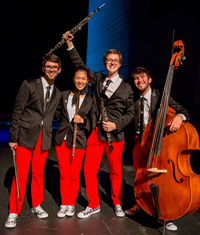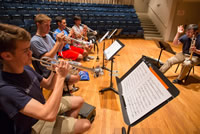Allegro
The Next Generation
National Youth Orchestra challenges new musicians to hit the high notes
Volume 114, No. 2February, 2014

Members of the National Youth Orchestra enjoy top instruction and get the chance to tour. Photo by Chris Lee.
“We have to go and show these people what classical music is. We say sometimes that classical music has a small audience, but it’s because people don’t have the chance to be closer to it.” – Gustavo Dudamel
“I would teach children music, physics, and philosophy; but most importantly music, for the patterns in music and all the arts are the keys to learning.” – Plato
The classical music audience is aging and shrinking. That fact, which many who play or work in the classical music world have been witnessing first hand, was officially revealed in a 2011 study by the National Endowment for the Arts, which looked at age and arts participation over a 26-year time period.
The NEA’s study ultimately concluded the following: education has an important influence on arts participation. Yet, arts education – and specifically music education – continue to be systematically cut from our public school curriculum.
So how do we provide this much-needed education to our youth? One answer is not necessarily new but it’s something that has been a long time coming in the United States: the concept of a national youth orchestra.
On the international scene, national youth orchestras have existed for over 60 years, the oldest being the National Youth Orchestra of Great Britain, founded in 1948. Many other countries have national youth orchestras, including the major European and Scandinavian countries, Canada and even Iraq. Perhaps the most famous and successful one is from Venezuela, the government funded Simon Bolivar Symphony Orchestra, founded by José Antonio Abreu in 1975 for children from poor and impoverished communities. In fact, it’s proven to be so successful that Venezuela has actually established satellite versions of the orchestra in other countries, including the U.S.
Here, the youth orchestra has predominantly been on the state level. For example, the New York Youth Symphony was established in 1962 and is still going strong (see sidebar on page 17). Other states have similar programs.
The United States first attempted a national youth orchestra in 1940, when Leopold Stokowski established the All -American Youth Orchestra. Although short-lived, it was the first of its kind. The musicians were from all 48 states. After an intensive but concentrated rehearsal period, the orchestra toured the U.S. and South America.
More than anything, Stokowski understood the importance of nurturing not only great musicians but future patrons of the arts. He believed that his youth orchestra could act as young emissaries of freedom, the complete antithesis of Hitler’s youth. The program disbanded in 1942 with any future plans put on hold as World War II escalated.
Fast forward seven decades and enter Sir Clive Gillinson. When Gillinson was appointed the executive and artistic director of Carnegie Hall in 2005, he envisioned re-establishing a national youth orchestra in the U.S. He himself was a cellist in the National Youth Orchestra of Great Britain, and that experience remains one of the most vivid experiences of his life. Gillinson went on to play with the London Symphony Orchestra, and ultimately became its manager, establishing a number of music education programs there.
Finally, last June, Gillinson’s vision was finally realized. The National Youth Orchestra of the United States was inaugurated, 72 years after Stokowski’s original inspiration.

David Krauss, principal trumpet with the Metropolitan Opera Orchestra, instructs the
National Youth Orchestra trumpet section on articulation. Photo by Chris Lee.
This new youth orchestra actually has a multifaceted mission. It provides an opportunity for high school musicians to participate in a professional-level performance program. It gives young people a chance to develop personal and artistic relationships with their peers. Finally, according to Gillinson, “a key element which doesn’t exist for many of the other national youth orchestras around the world was we also wanted it to be a youth ambassador for America, traveling to places where America has really important relations.”
Last year, in its first season, the National Youth Orchestra brought together 120 high school students (ages 16 to 19) from all over the U.S. For two weeks, students participated in an intensive training program in Purchase, New York. Then the students toured the U.S., Russia and England. Guest artists last year included conductor Valery Gergiev and violinist Joshua Bell.
A great program needs a great faculty. The teachers are all highly skilled and talented players, many of them principals for major orchestras such as the New York Philharmonic, Metropolitan Opera Orchestra, Chicago Symphony Orchestra, Los Angeles Philharmonic and the Philadelphia Orchestra. Not only are these some of the best players in the country, but they are also all members of union orchestras.
Local 802 member David Krauss, who plays principal trumpet with the Metropolitan Opera Orchestra, was honored to be hired as faculty during this inaugural year. Like Clive Gillinson, and many others, Krauss himself had a pivotal experience with a youth orchestra – the “Solti Orchestral Project” at Carnegie Hall, a training workshop for young American musicians. For Krauss, this was an invaluable experience that helped him forge lifelong professional and personal relationships.
One of those relationships was with Michael Sachs, principal trumpet of the Cleveland Orchestra. Krauss said, “It was great to sit next to a great trumpet player when a youth. This was a great connection.” It’s not surprising, then, that when Krauss received an e-mail asking if he wanted to be on faculty for the National Youth Orchestra, he agreed. This was an opportunity to carry on the legacy, to be for the next generation what Michael Sachs had been for him.
Krauss also said, “Carnegie creates a definitive version of whatever they do. Taking these students on tour with Gergiev is an experience most professional musicians covet. These kids are still in a coma from the experience.”
So, why should we care about a National Youth Orchestra, or youth orchestras in general, especially in a time when our professional orchestras are struggling to survive? Youth orchestras bring together a diverse group of students and create a sense of pride, accomplishment, camaraderie and community. Add to this the touring aspect of the program and you have something priceless.
These experiences are helping to mold young musicians, who some day may play in top orchestras. As the musicians’ union, we have a responsibility to work for our current members and our future members.
Of course, with all of the problems facing live classical music, many of these students may not find work as professional musicians. But this experience, according to Clive Gillinson, is about more than just the playing. It is about cultivating music ambassadors. These teenagers are developing not merely their love of playing, but also their love of the art form. Many of them will go on to become patrons of classical music. Supporting youth orchestras cultivates future audiences. And audiences are the key to the future of classical music.
In fact, Local 802 is already involved in these movements because we have members who are involved. The National Youth Orchestra, as well as the New York Youth Symphony and other educational youth orchestras, present Local 802 with a chance to be more directly invested in the diverse education of these future musicians, members and patrons. So…are we ready to hit the high note?
